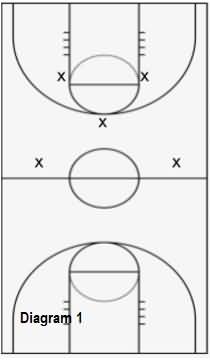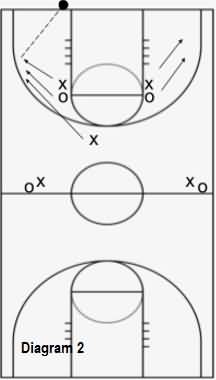Paul Murray's 21 Full Court Press
From the Coach’s Clipboard Basketball Playbook"Helping coaches coach better..."
Disclosure: This page contains affiliate links, which means that Coach's Clipboard receives a small commission (at no cost to you) if you make a purchase using these links.
March 8, 2023 - Last year, Paul Murray left his position as assistant coach at perennial North Carolina power, The Burlington School, to become head coach of Henderson Collegiate, a public high school. His new team had lost almost its entire roster to graduation. Not surprisingly, they struggled through the June live period, only managing a 2-13 record.
But when winter rolled around, without adding any new players, Murray's team went 16-11 against a gauntlet of tough opponents, en route to a conference title. Remarkably, they routinely forced opponents to turn over the ball 30 or more times per game.
The secret was Murray's innovative full-court press, which he calls "21". Part man-to-man and part zone, it presents confusing pressure and forces opponents to deviate from their game plans
Perhaps the greatest advantage of the 21 press is that it lets the defense switch seamlessly between defensive schemes, even after the ball is inbounded. In the same way that professional football teams rapidly change defensive alignments at the line of scrimmage, the 21 press can instantly switch from being a zone defense to man-to-man, or from one type of zone to another.
Here's how it works:
The Formation
Diagram 1. Rather than guard the inbounder, Murray positions an extra defender in space to read and react to the movement of the ball.The basic formation has two defenders on the elbows ("up men"), one defender floating at the top of the key ("spy"), and two defenders around half court ("safeties").

The Roles
The "up men" are responsible for denying the inbound pass (diagram 2). When their team scores, they turn their backs to the baseline and completely deny whoever is in their zone. They get up against the offensive players, eliminating any cushion.The "spy" floats near the top of the key, reading the inbounder's eyes. If the inbounder tries to lob the ball over the top of the "up men," the "spy" can read it and come up with easy steals.

If one of the guards gets open, the "spy" becomes a designated trapper. He and the on-ball "up man" take space with a quick contact trap. The other "up man" rotates to deny a return pass to the inbounder (diagram 3), and the two "safeties" play the remaining three.
Each "safety" drops as far back as the deepest offensive player on their side. This usually means they start near half court. If the ball is inbounded to their side, they deny one pass away up the sideline. The weak side "safety" plays the other two offensive players. He is responsible for rotating back to protect the rim.

Oftentimes, opponents struggle to get their guards open to receive the inbound pass, so they flash someone late to either the middle or up the sideline. In this case, a "safety" will ¾ deny their man, no matter how far towards the ball they go. If a guard goes deep and big flashes, the "safety" and "up man" communicate and switch.
The first pass is similar to a zone press, where there are set roles. The closest defender, along with the "spy," come together to trap. If this initial trap is broken, the press operates like a "run and jump" man, where everyone picks up the nearest offensive player and follows them regardless of where they go on the court. If the ball handler looks out of control, the nearest gap defender has the license to leave his man and trap the ball.
Tactical Adjustments
Opponents often try unique press breaks against the 21 press. For example, sometimes they start three or four players at half court, before flashing to the ball. In this case, the basic defensive alignment remains, with the entire zone moving up towards halfcourt to take space. The "up men" pick up the first two flashers, with "safeties" running up with the remaining offensive players.Conversely, if more than two offensive players start close to the inbounder, the "safeties" come up to ¾ deny the extra offensive players.